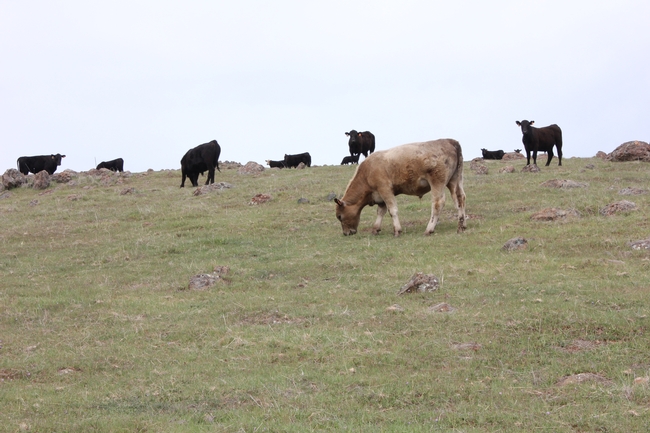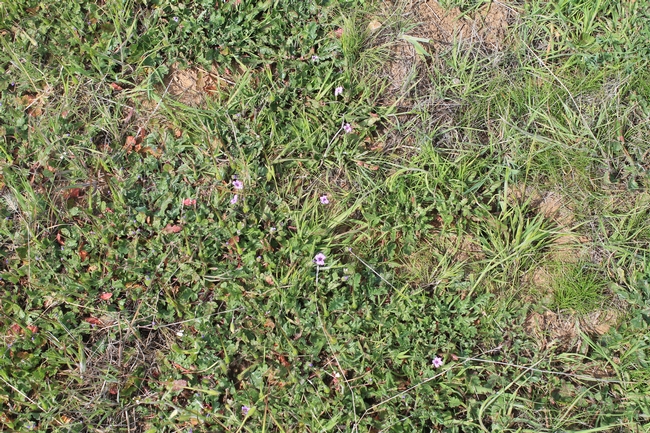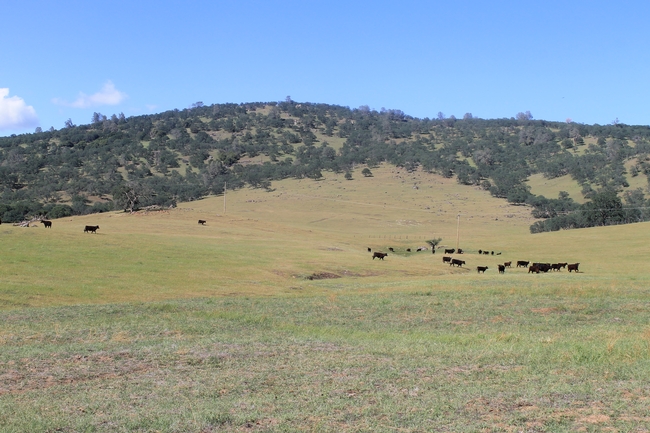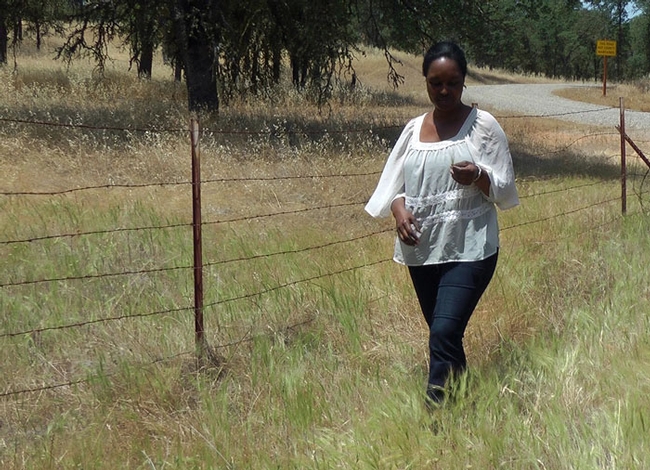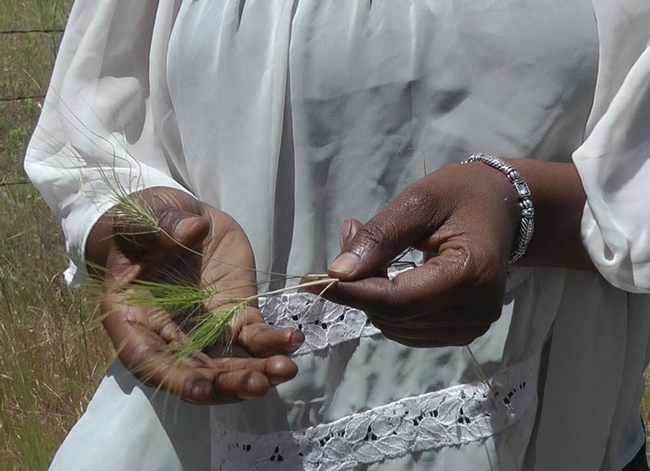Posts Tagged: Fadzayi Mashiri
Low residual dry matter on rangeland a concern heading into wet season
With some recent forecasts bringing encouraging news about a potential El Niño, some ranchers have been asking about what they should expect in terms of forage production, if and when the rains come. What they want to know is how soon rangeland productivity will reach the pre-drought levels again. One issue that I always draw their attention to is the levels of residual dry matter (RDM) on the rangelands. Even with the reduction in herd sizes and shorter grazing seasons employed by most producers, more rangelands now have less than recommended RDM levels.
RDM is a measure of the old plant material (without counting summer annuals) that are left standing or on the ground before the fall precipitation comes. It is a great indicator of both forage production and grazing intensity. These leftover plant materials are critical on California rangelands to reduce erosion and nutrient loss, and to create a conducive environment for diverse plant communities to thrive. Optimum RDM levels are site specific, they range from 100-2,100 pounds per acre, and depend on precipitation zone, slope and tree canopy cover. Ideal RDM levels increases with precipitation and slope, and decreases with tree cover. Studies show that too low or too high RDM levels will reduce species composition and forage production, both factors critical to any livestock production system. The good news is that annual rangelands are resilient and will likely return to normal production within two years after bringing RDM level to recommended standards.
Knowing the RDM standards for one's rangeland and continuously monitoring is an important step towards achieving sustainable rangeland management and livestock production.
Details about RDM standards, data collection methods and more can be found in the free UC Agriculture and Natural Resources publication Guidelines for Residual Dry Matter on Coastal and Foothill Rangelands in California.
Author: Fadzayi Mashiri, Ph.D.
Fast and easy rangeland monitoring using repeat photography
Statements such as: "This year is the best (or worst) grass year of my adult life" or "We started seeing this weed on our property about 10 years ago and now it is all over" are commonly used to describe rangeland condition. Although such statements are most likely correct, what is lacking in most cases is rangeland monitoring data to support these statements.
What is rangeland monitoring? Rangeland monitoring is observing, collecting and analyzing data to document change over time and how these changes may relate to management and environmental factors such as climate and soil.
Landowners need monitoring programs to detect:
- Rangeland improvement so they know to continue the good management
- Negative changes in order to take corrective measures
- Weed infestation in order to start weed control
- Effects of an extreme event, e.g. drought.
Although most ranchers and rangeland scientists agree that rangeland monitoring data is critical for landowners to make informed management decisions and to better understand rangeland ecosystems, the problem is that most monitoring protocols can be time consuming and data too complex to analyze and interpret. This is especially true for rangeland managers and landowners who are busy with all the day-to-day land, animal and infrastructure management. As a result most find it difficult to add consistent rangeland monitoring to their schedules.
However, repeat photography, which is a simple and fast monitoring method that produces easy to interpret information, can be the answer. Although repeat photography does not provide detailed information, it can show changes in plant growth, plant cover, species composition, residual biomass, litter and vegetation structure.
Establishing a good repeat photo monitoring protocol involves selecting the right 1) site to take photos, 2) plot size (small plot to landscape view), 3) timing (what season) and 4) frequency (how often) to take photos, based on the goals. When monitoring for trends at management unit level, it is best to select a site that is representative of a largest part of the management unit.
For more information, see the UC Agriculture and Natural Resources guideline for using photographs to monitor rangeland, Photo-Monitoring for Better Land Planning and Assessment.
Ranchers concerned about invasion of medusahead weed on foothill rangeland
One of the worst rangeland weeds in the West is aptly named after a monster in Greek mythology that has writhing snakes instead of hair.
Medusahead, an unwelcome transplant from Europe, is anathema to the cattle living off rangeland grass. The weed's three-inch-long bristles poke and sometimes injure the animals' mouths and eyes. The weed is also low-quality forage for livestock. When medusahead takes over rangeland, it reduces the forage value by 80 percent.
When Fadzayi Mashiri, UC Cooperative Extension advisor in Mariposa, Merced and Madera counties, was appointed in 2013, she became the first natural resources and rangeland expert to hold the position since the retirement of Wain Johnson more than a decade before. She polled local ranchers to determine their most pressing problems. They said weed management, and in particular, medusahead.
Medusahead is relatively easy to identify on the range. It has distinctive stiff awns and a seed head that does not break apart as seeds mature. Patches of medusahead are obvious when spring turns into summer.
“Medusahead stays green after most of the annual grasses have dried off,” Mashiri said.
Medusahead has high silica content, making it unpalatable to cattle. The silica also protects the plant from decomposition, so a thick thatch builds up on the rangeland, suppressing more desirable species, but not the germination of the next year's medusahead seedlings.
Over the years, UC scientists have discovered a number of medusahead control strategies:
- Corral cows on medusahead before the plant heads out or employ sheep to graze medusahead patches. It's not sheep's favorite forage either, but they will eat if left with no other option.
- Prescribed burning in late spring or early summer. However, this strategy poses air quality and liability issues.
- Apply nitrogen fertilizer to medusahead to improve palatability before it flowers, which is showing promise for controlling the weed and boosting the value of infested rangeland.
- Chemical control.
In spring 2014, Mashiri conducted a demonstration field trial in Mariposa County of medusahead control with the herbicide Milestone, which was developed by Dow AgroSciences mainly to control broadleaf weeds like yellow starthistle. The trial followed rangeland weed control research done by scientists including Joe DiTomaso, UC Cooperative Extension specialist in the Department of Plant Sciences at UC Davis. DiTamaso found that the density of medusahead in treated areas declined and concluded that Milestone prevents medusahead seedlings from thriving.
Unfortunately, Milestone treatment of large rangeland areas is expensive.
“But if the value of forage declines, the productivity of livestock is compromised,” Mashiri said. “When you look at it that way, the chemical treatment might be useful.”


